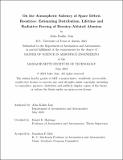On the Atmospheric Saliency of Space Debris Reentries: Estimating Distribution, Lifetime and Radiative Forcing of Reentry-Ablated Alumina
Author(s)
Jain, Asha Kailin
DownloadThesis PDF (41.61Mb)
Advisor
Hastings, Daniel E.
Terms of use
Metadata
Show full item recordAbstract
As the space economy grows, numerous satellite operators are looking to build megaconstellations in Low Earth Orbit (LEO). These megaconstellations are expected to have hundreds to thousands of satellites operating in altitudes from 350km to 650km. Once built, many of these constellations will require satellite replenishment to replace spent satellites, leading to a continuous flow of new satellites and rocket bodies into LEO.
To make room for future satellites, decommissioned space objects are often removed from LEO via atmospheric reentry. During reentry, unshielded satellites and rocket bodies experience extreme heating loads and material ablation, depositing small metallic particles in atmosphere. These particles can remain suspended in the atmosphere and interact with important atmospheric processes. However, the salience of these particles and their atmospheric effects are unknown.
To address this gap, this thesis estimates the atmospheric consequences of reentry-ablated alumina, characterizing its distribution, lifetime and radiative effect using a state-of-the-art atmospheric model. We consider a future scenario where all of the megaconstellations with public Federal Communications Commission filings are deployed and maintained, leading to steady flux of 13,900 satellite reentries and 500 rocket body reentries per year by 2040. As a first order, conservative approximation, this work finds that reentries in this scenario produce alumina particles that persist in the atmosphere for one to two years, leading to a modest radiative forcing of approximately \(-0.2 mW/m^2\). We present various metrics to normalize this radiative forcing and compare these metrics across other industries. Reentries produce a stronger radiative forcing per reentry event than the radiative forcing that aviation produces per flight. We conclude that future work is necessary to increase the fidelity of our results and better understand the full scope of atmospheric consequences of reentry-ablated alumina.
Date issued
2023-06Department
Massachusetts Institute of Technology. Department of Aeronautics and AstronauticsPublisher
Massachusetts Institute of Technology